|
How to Get Your Own Element Collection
Home
From time to time, people ask me how to put together an element collection, or how much it would
cost if they wanted me to make another table for them. To the latter question my answer is that I'm
in the software business, not the furniture business, but hey, start writing zeros on the napkin and
I'll tell you when to stop.
To the former question, I have several answers. One nice
thing about collecting elements is that there isn't a company constantly
manufacturing more of them for you to collect, like there is with Beany Babies
and the like. You can actually finish at some point, if you stop at elements
with a halflife of at least a year.
Many people who collect elements concentrate on natural mineral samples
containing them, and others concentrate on ultra-pure samples. An example
of the former is Jim Marshall
from the University of North Texas, who actually takes his element collection
on tour sponsored by the American Chemical Society. He has a wonderful
book and CD about
it and he plans to publish a new one that will include the GPS coordinates
of where each of the elements was originally discovered, so you can go visit
there yourself. An example of a pure-element
collector is David Franco
who has sent me many very nice and very pure elements
for my collection.
Another option is to collect interesting things that have some element in them, even if
it's not especially pure or natural. That's the way I've decided to go. For example,
I have spark plugs that contain yttrium not
because they are a good representative sample of yttrium but rather because I think it's
bizarre and interesting that anyone would make a spark plug containing yttrium.
In fact, I have a whole sub-collection of
spark plug elements.
Depending on your interests, here are some different ways of putting together an element collection:
|
|
|
1. Buy a ready-made set
It's possible to buy reasonably complete sets of 90+ elements for between $300 and $1700 depending
on the size and quality of samples you want. You'll get a nice wooden box with a grid of bottles or vials arranged
in the form of a periodic table.
Click on any (or at least most) of the pictures below to get a large version in a separate window.
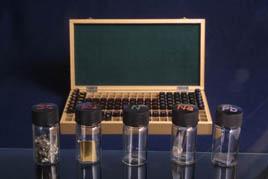 The RGB Set
The RGB Set
A very nice set is being produced by
The Red Green & Blue Company in England. (Disclaimer: I'm now in business
with RGB producing large scale museum displays, described below, so consider me a biased source for information about their sets. Did I mention
they are very nice sets?) Click on the link to go
to their web site, which has many photographs and an extremely detailed set of answers to all the questions you
might have about the set. Or, you can see photographs of all the samples
from the set displayed on my web site. I have two sets of photographs of all the samples, one taken by me
and one supplied by the company. You can see my pictures or
the company's pictures in a periodic table layout, or
both pictures side-by-side in numerical order.
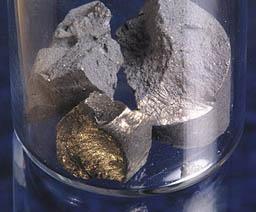 The samples in this set generally consist of solid lumps or in some cases chips or foils. Each sample is
packaged in a sealed glass bottle with a lid engraved with the element symbol.
The samples in this set generally consist of solid lumps or in some cases chips or foils. Each sample is
packaged in a sealed glass bottle with a lid engraved with the element symbol.
The set comes in several versions, the most expensive containing at least one gram of every
element it's reasonable to actually have a gram of, including several radioactive elements. Less expensive versions
omit the radioactive elements and/or have smaller samples of expensive elements.
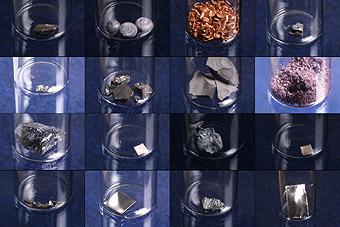 The company has paid a great deal of attention to safely, so for example all the radioactives are cast in solid resin
inside the bottles to prevent any possibility of them escaping. Poisonous elements like beryllium come in solid lump
form, which is the safest form available. With reasonable care, it should be OK to use these sets in the
classroom and with children of average activity level.
The company has paid a great deal of attention to safely, so for example all the radioactives are cast in solid resin
inside the bottles to prevent any possibility of them escaping. Poisonous elements like beryllium come in solid lump
form, which is the safest form available. With reasonable care, it should be OK to use these sets in the
classroom and with children of average activity level.
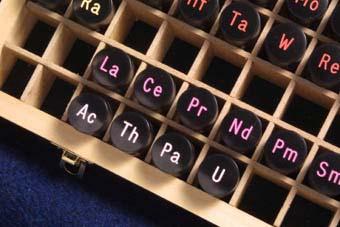 The price of the sets is really very fair: If you do the math, it would cost you much more to assemble the same quantity
of all the elements individually, and several of them are actually quite difficult to track down in safe, non-powder form.
The price of the sets is really very fair: If you do the math, it would cost you much more to assemble the same quantity
of all the elements individually, and several of them are actually quite difficult to track down in safe, non-powder form.
The samples in this set are large enough to give a good impression of the elements as real, physical objects.
You can shake osmium, for example, and really feel the density of the lump inside. Although the company is based in the UK, the
sets are shipped by a US distributor, so delivery to US customers is quick and reasonably priced.
Individual samples, much larger than the ones in these sets, are also available from RGB: See their website for prices and
descriptions of individual samples. Or, check out RGB's eBay listings,
where an ever-changing set of samples is available. About half these samples are prepared by Max, the other half are made by me. Generally
speaking he makes the fancy platinum group metals like osmium, iridium, etc, while I make the more common transition metals, like bismuth cylinders,
manganese ampoules, etc. I'm in the process of photographing the samples we offer: Click here to see
the ones I've photographed so far (many more are available so check the catalog or eBay).
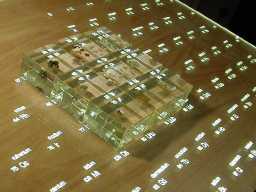
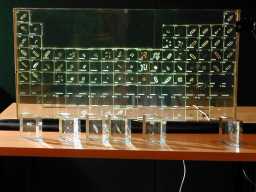
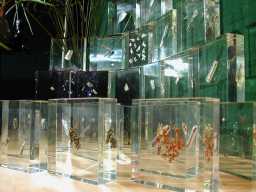
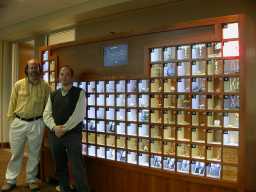
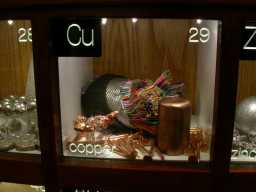 Max Whitby, the director of RGB, and I have formed a partnership to produce large-scale (3-foot to 10-foot wide) periodic table displays
for museums, science centers, corporate headquarters, universities, schools, and people wishing to have a really, really nice periodic table
display instead of a new car.
Max Whitby, the director of RGB, and I have formed a partnership to produce large-scale (3-foot to 10-foot wide) periodic table displays
for museums, science centers, corporate headquarters, universities, schools, and people wishing to have a really, really nice periodic table
display instead of a new car.
There are two basic versions, resin block and wood. The resin block versions (3-foot and 6-foot) contain each element in a separate solid
block of cast resin, stacked into the shape of the periodic table with illuminated lettering on a panel in back. They can be free-standing
or hung on the wall, and are spectacular either way.
Even more spectacular is the wood version, which is 10 feet wide, 7 feet high, and housed in a hand-made solid wood cabinet with illuminated
Lucite panels and 600 individual super-bright white-light LEDs providing the illumination. Far more than an element collection, this is
a work of art that creates a sensation wherever it is installed. When the first one was
installed at DePauw university, it was
front page news.
Each element gets a 6-inch cube, which allows room not just for a large pure sample, but also a mini-diorama of different forms, minerals, and application examples.
These displays bring together an incredibly diverse range of objects and materials into a single display of great depth and beauty.
For more information including pricing, visit periodictabledisplay.com.
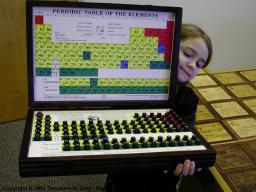 The Everest Set
The Everest Set
An element set used to be offered by a company called Everest from Russia, but they had not been available since the
early 1990's. The remaining stock of the American distributor was bought up by Rob Accurso, who has occassionally
been offering them for sale on eBay.
This link will take you
to a current eBay listing if there is one.
Arbor Scientific offered a new version of the set for a while, but discontinued selling it in December, 2003.
You can see photographs of all the samples from the set displayed on my web site in a periodic table layout or
with bigger pictures in numerical order.
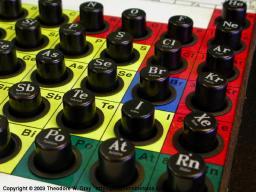 This set gets an A+ for presentation, coming in a beautiful wooden box with a nicely printed periodic table inside
the lid. The samples are contained in sealed glass ampules each about an inch high. Fixed to the top of each ampule is
a metal cap printed with the symbol and name of the element. Each ampule fits into a very nice metal-rimmed hole
backed by a foam pad which holds the ampule firmly.
This set gets an A+ for presentation, coming in a beautiful wooden box with a nicely printed periodic table inside
the lid. The samples are contained in sealed glass ampules each about an inch high. Fixed to the top of each ampule is
a metal cap printed with the symbol and name of the element. Each ampule fits into a very nice metal-rimmed hole
backed by a foam pad which holds the ampule firmly.
The actual element samples are quite small. The standard size is 0.25 grams except for the gasses which
are however much fits in the ampule. The set contains no radioactive elements, so there are a total of 82 actual
samples, but it does have a total of 108 nicely labeled ampules with a funny gold flaky powder used to represent
the radioactive and artificial elements.
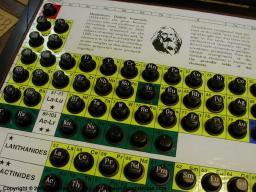 Many of the samples are powders ranging from very fine (rhodium, osmium) to granular (chromium, platinum). The
rare earths are actually some of the best samples, being mostly chips rather than powders. Scandium is particularly
attractive, as are the alkali metals in their shiny mini-tubes. There are surprisingly large amounts of cesium, rubidium,
and bromine. (I should say that I'm basing this on the one set I have: There may be variation between sets.)
Many of the samples are powders ranging from very fine (rhodium, osmium) to granular (chromium, platinum). The
rare earths are actually some of the best samples, being mostly chips rather than powders. Scandium is particularly
attractive, as are the alkali metals in their shiny mini-tubes. There are surprisingly large amounts of cesium, rubidium,
and bromine. (I should say that I'm basing this on the one set I have: There may be variation between sets.)
I have to mention the beryllium sample because it represents a significant health problem. Beryllium is extremely toxic
if it is in a form that can be inhaled, namely a powder. The set I received contained
powdered beryllium, with
the granularity varying from small shavings down to quite fine powder. This is a very bad idea: Under no
circumstances should this ampule be allowed in the hands of children who might break it. Arsenic would be
similarly toxic, but it came in the form of solid lumps, which are much less dangerous than a powder would be.
All in all, I'd like this set better if there were fewer powders and if the cheaper elements had larger samples.
(I can understand including only a few grains of gold, but couldn't we have full ampules of iron and lead?)
Think of it as a very supped up periodic table poster and you won't be disappointed. It probably won't get
many kids excited about chemistry on its own, but for an older student already interested it would be an outstanding gift.
The price is definitely right: You are unlikely to find a set like this so cheap any time soon, and the number available
is very limited.
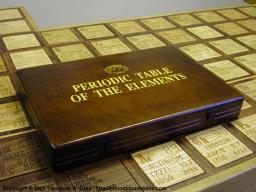 This is a very portable set, though you'd be sad if you scuffed up the nice wooden box while carrying it around.
Amusingly, it came with a page entirely in Russian, with several official-looking stamps and signatures.
According to our resident Russian, it is a certification that the set conforms to all regulations and is legal
to ship by any means including by aircraft. This is, for lack of a better description, probably a good example of what
a case of vodka will buy you at a government ministry in Russia. Especially in powdered form, quite a few of
these elements may not be shipped by air at all, and may not even be sent by cargo ship if they are together as part
of the same shipment (on the theory that they might react with each other). Of course those regulations are
silly when applied to such tiny quantities, so we see that there is a positive side to a government
run on lubrication.
This is a very portable set, though you'd be sad if you scuffed up the nice wooden box while carrying it around.
Amusingly, it came with a page entirely in Russian, with several official-looking stamps and signatures.
According to our resident Russian, it is a certification that the set conforms to all regulations and is legal
to ship by any means including by aircraft. This is, for lack of a better description, probably a good example of what
a case of vodka will buy you at a government ministry in Russia. Especially in powdered form, quite a few of
these elements may not be shipped by air at all, and may not even be sent by cargo ship if they are together as part
of the same shipment (on the theory that they might react with each other). Of course those regulations are
silly when applied to such tiny quantities, so we see that there is a positive side to a government
run on lubrication.
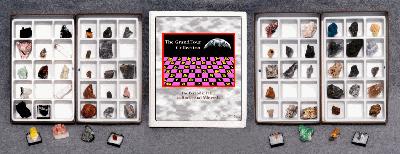 The Jensan Mineral Set
The Jensan Mineral Set
A company called Jensan Scientifics sells a collection
of minerals called "The Grand Tour of the Periodic Table".
The set includes 60 minerals representing the elements of the periodic table. Of course few minerals are pure
elements, so many of the samples are compounds that contain the given element. In exchange, they are beautiful in a way that only
natural minerals can be. It's a wonder to think that beautiful crystals like these just come up out
of the ground, formed by natural forces deep in space and time.
Sarah at Jensan's is sending me the collection one box at a time for me to photograph and
include in the periodic table collection (she also sent me a nice
periodic table poster based
on an expanded version of the set). Over the next month or two you'll see photos and 3D models of all these
minerals appearing on my site.
You can see photographs of all the samples I have so far displayed on my web site in a periodic table layout or
with bigger pictures in numerical order.
The Grand Tour set costs $635, and they also have smaller collections representing subsets of elements
available at a range of prices: Visit them at www.sciencemall-usa.com.
|
|
|
2. Buy My Poster
I publish a photographic periodic table poster with pictures taken from my collection. Sometimes pictures are
frankly more interesting than real samples, which can be too small to see well in person. And posters don't have
any health and safety issues: You can put one up anywhere, even in places where radioactive elements would
raise eyebrows. Here's what it looks like (click to go to a page where you can see larger versions or order your own copy):
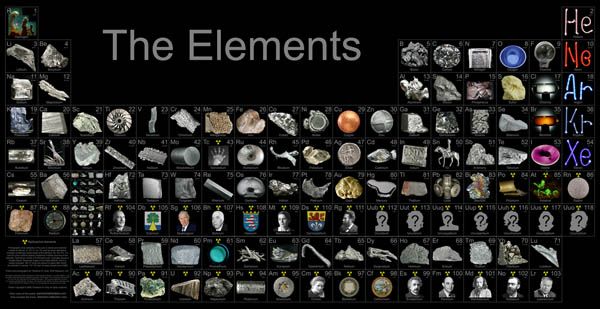
You can buy a copy right now!
3. Buy Elements from a Chemical Supplier
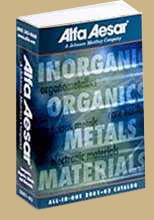 There are several full-line chemical supply houses that sell virtually every element in any number of different forms
(ingots, powders, sheets, rods, you name it). They generally offer a range of purities from 95% to 99.99999+%, at a
range of prices. This is a pretty expensive way to get elements: You're paying a premium for guaranteed purity and
careful packaging. And they are generaly not interested in selling to individuals, preferring to deal with
companies and research institutions. Chemical companies of this nature used to be the only way to get some
of the more exotic elements, but these days eBay is surprisingly comprehensive.
There are several full-line chemical supply houses that sell virtually every element in any number of different forms
(ingots, powders, sheets, rods, you name it). They generally offer a range of purities from 95% to 99.99999+%, at a
range of prices. This is a pretty expensive way to get elements: You're paying a premium for guaranteed purity and
careful packaging. And they are generaly not interested in selling to individuals, preferring to deal with
companies and research institutions. Chemical companies of this nature used to be the only way to get some
of the more exotic elements, but these days eBay is surprisingly comprehensive.
|
|
|
4. Scrounge around on eBay, at Walmart, Hardware stores, etc.
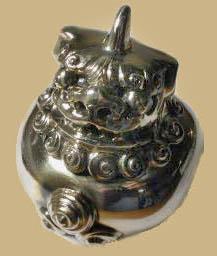 If you look through the list of sources and contributors of the elements in my
collection, you'll see that I got a large number of them from one of two sources: Walmart and eBay. In fact,
I have a special list of all the elements you can get at Walmart specifically.
If you want to follow this path, you can use my list of sources as a starting point: Many of the eBay sellers
are repeat sellers who probably have an element or two on offer right now.
If you look through the list of sources and contributors of the elements in my
collection, you'll see that I got a large number of them from one of two sources: Walmart and eBay. In fact,
I have a special list of all the elements you can get at Walmart specifically.
If you want to follow this path, you can use my list of sources as a starting point: Many of the eBay sellers
are repeat sellers who probably have an element or two on offer right now.
I've gotten so involved in element collecting that I now, in partnership with Max Whitby of the RGB Company,
offer a line of museum-quality element samples on eBay.
Our samples are high-end: Not the cheapest but definitely the best. Many are sealed in argon-purged glass ampoules, for example.
Another good seller is David Franco, who also has a
non eBay web page: http://elements.daemon.net and an email
address of
.
You'll want to use eBay's search feature to find new sellers and new kinds of objects. Some elements are
easy to search for because no one uses their name unless they're selling that element. Other elements, like vanadium,
are a pain because there are hundreds and hundreds of listings for things made of chrome-vanadium steel, for example.
You have to throw in terms like "pure", or "chemical" to limit the search. You could search just in the appropriate
categories of lab supplies, scientific collectibles, etc. But then you'd miss the most interesting objects, like this
antique Foo Lion incense burner made of antimony.
There are certain objects, like this one, for which there did not
exist a mechanism by which one could possibly find one, before the invention of eBay. Think about it: Where
on earth would you go if you wanted an antimony Foo Lion incense burner, if not eBay?
The harder ones, scandium, promethium, most of the rare earths, are usually not available this way, except
from a small number of sellers like David Franco (see above).
In my case, I also got an incredible amount of support from people who thought my web site was fun and offered to
trade or donate elements. I think I tapped into a rich vein of people who had had an element or two around
the house for a decade or three and were actually kind of relieved to find someone who would give it a good home.
If you can't find people like that, you may be forced to use method #1 or #2 to complete your collection. As long as
you keep the number of elements you buy from a chemical supplier to a minimum, the cost won't be too outrageous.
Or you could buy one of the complete sets after you give up on the rare ones.
|
|
|
5. Collect periodic table posters instead.
It's not quite the same thing, but some people make a hobby of collecting periodic table posters.
There are a great variety of them! I have tried, not entirely successfully, to avoid this type
of object, but see my page about it for more information.
|
|
|
6. Read a book.
This isn't really a way to collect elements, but if you're interested in elements, here are some of the very
best books. Some are stories that may not have a whole lot to do with elements, others have factual information
about each element.
Uncle Tungsten, by Oliver Sacks (Literary)
Nature's Building Blocks: An A-Z Guide to the Elements, by John Emsley (Factual)
The Elements, by John Emsley (Factual)
The Periodic Table, by Primo Levi (Literary)
Discovery of the Elements, by Jim Marshall. (Factual)
Rediscovery of the Elements, by Jim Marshall. (Factual)
Living With Radiation: The First Hundred Years, by William Kolb and Paul Frame (factual)
|
|
|
|